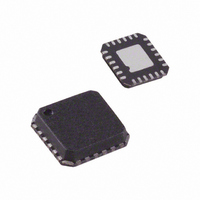AD7147PACPZ-RL Analog Devices Inc, AD7147PACPZ-RL Datasheet - Page 18

AD7147PACPZ-RL
Manufacturer Part Number
AD7147PACPZ-RL
Description
CAPACITANCE TO DIGITAL CONVERTER
Manufacturer
Analog Devices Inc
Series
CapTouch™r
Type
Capacitive Sensor Controllerr
Datasheet
1.AD7147ACPZ-1500RL7.pdf
(72 pages)
Specifications of AD7147PACPZ-RL
Resolution (bits)
16 b
Data Interface
I²C
Voltage Supply Source
Single Supply
Voltage - Supply
2.6 V ~ 3.6 V
Operating Temperature
-40°C ~ 85°C
Mounting Type
Surface Mount
Package / Case
24-LFCSP
Lead Free Status / RoHS Status
Lead free / RoHS Compliant
Sampling Rate (per Second)
-
Lead Free Status / RoHS Status
Lead free / RoHS Compliant
Available stocks
Company
Part Number
Manufacturer
Quantity
Price
Part Number:
AD7147PACPZ-RL
Manufacturer:
ADI/亚德诺
Quantity:
20 000
AD7147
NONCONTACT PROXIMITY DETECTION
The AD7147 internal signal processing continuously monitors
all capacitance sensors for noncontact proximity detection. This
feature provides the ability to detect when a user is approaching
a sensor, at which time all internal calibration is immediately
disabled while the AD7147 is automatically configured to detect
a valid contact.
The proximity control register bits are described in Table 12. The
FP_PROXIMITY_CNT and LP_PROXIMITY_CNT register
bits control the length of the calibration disable period after
the user stops touching the sensor and is not in close proximity
to the sensor during full or low power mode. The calibration is
disabled during this period and then enabled again. Figure 30
and Figure 31 show examples of how these registers are used to set
the calibration disable periods for the full and low power modes.
The calibration disable period in full power mode is the value
of the FP_PROXIMITY_CNT multiplied by 16 multiplied by
the time for one conversion sequence in full power mode. The
calibration disable period in low power mode is the value of the
LP_PROXIMITY_CNT multiplied by 4 multiplied by the time
for one conversion sequence in low power mode.
RECALIBRATION
In certain situations (for example, when a user hovers over a
sensor for a long time), the proximity flag can be set for a long
period. The environmental calibration on the AD7147 is sus-
pended while proximity is detected, but changes may occur
to the ambient capacitance level during the proximity event.
This means that the ambient value stored on the AD7147 no
longer represents the actual ambient value. In this case, even
when the user is not in close proximity to the sensor, the prox-
imity flag may still be set. This situation can occur if the user
interaction creates some moisture on the sensor, causing the
new sensor ambient value to be different from the expected
value. In this situation, the AD7147 automatically forces a
recalibration internally. This ensures that the ambient values
are recalibrated, regardless of how long the user hovers over
the sensor. A recalibration ensures maximum AD7147 sensor
performance.
The AD7147 recalibrates automatically when the measured CDC
value exceeds the stored ambient value by an amount determined
Rev. B | Page 18 of 72
by the PROXIMITY_RECAL_LVL bits for a set period of time
known as the recalibration timeout. In full power mode, the recali-
bration timeout is controlled by FP_PROXIMITY_RECAL; in
low power mode, by LP_PROXMTY_RECAL.
The recalibration timeout in full power mode is the value of
the FP_PROXIMITY_RECAL multiplied by the time for one
conversion sequence in full power mode. The recalibration time-
out in low power mode is the value of the LP_PROXIMITY_
RECAL multiplied by the time for one conversion sequence in
low power mode.
Figure 32 and Figure 33 show examples of how the
FP_PROXIMITY_RECAL and LP_PROXIMITY_RECAL
register bits control the timeout period before a recalibration
while operating in the full and low power modes. In these
examples, a user approaches a sensor and then leaves, but the
proximity detection remains active. The measured CDC value
exceeds the stored ambient value by the amount set in the
PROXIMITY_RECAL_LVL bits for the entire timeout period.
The sensor is automatically recalibrated at the end of the
timeout period.
PROXIMITY SENSITIVITY
The fast filter in Figure 34 is used to detect when someone is close
to the sensor (proximity). Two conditions, detected by Compa-
rator 1 and Comparator 2, set the internal proximity detection
signal: Comparator 1 detects when a user is approaching or
leaving a sensor, and Comparator 2 detects when a user hovers
over a sensor or approaches a sensor very slowly.
The sensitivity of Comparator 1 is controlled by the
PROXIMITY_DETECTION_RATE bits. For example, if
PROXIMITY_DETECTION_RATE is set to 4, the Proximity 1
signal is set when the absolute difference between WORD1 and
WORD3 exceeds (4 × 16) LSB codes.
The PROXIMITY_RECAL_LVL bits (Address 0x003) control
the sensitivity of Comparator 2. For example, if PROXIMITY_
RECAL_LVL is set to 75, the Proximity 2 signal is set when the
absolute difference between the fast filter average value and the
ambient value exceeds (75 × 16) LSB codes.














